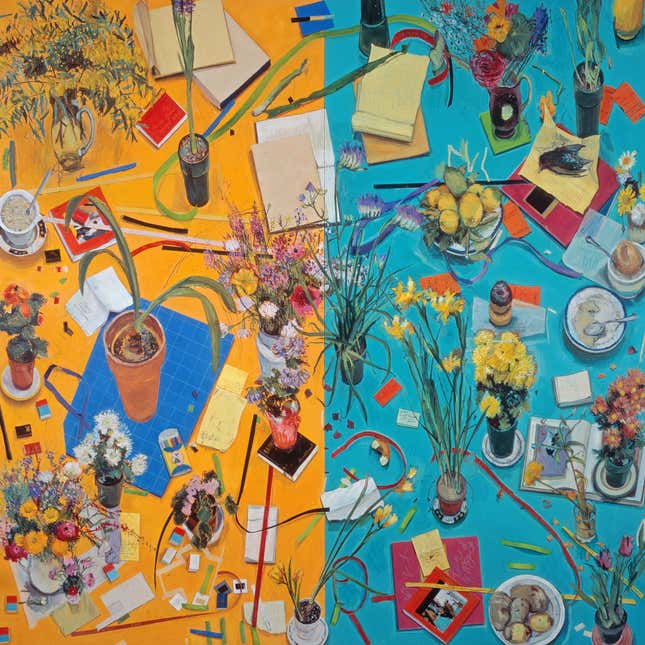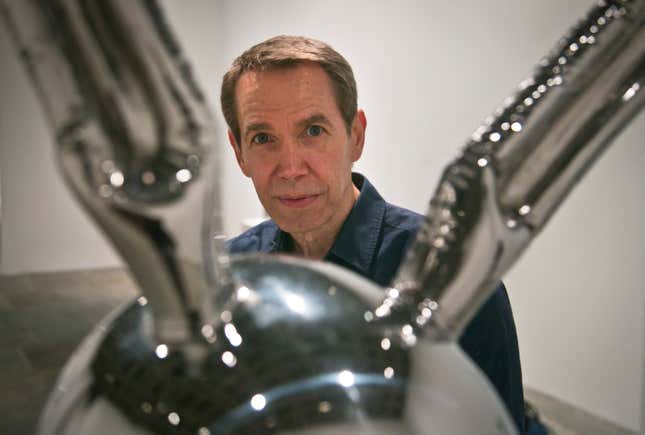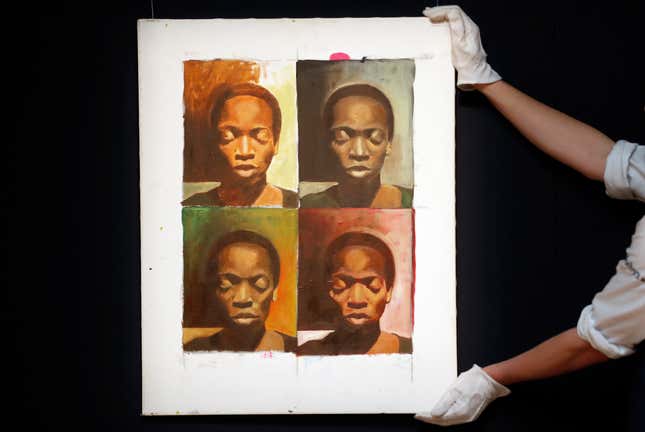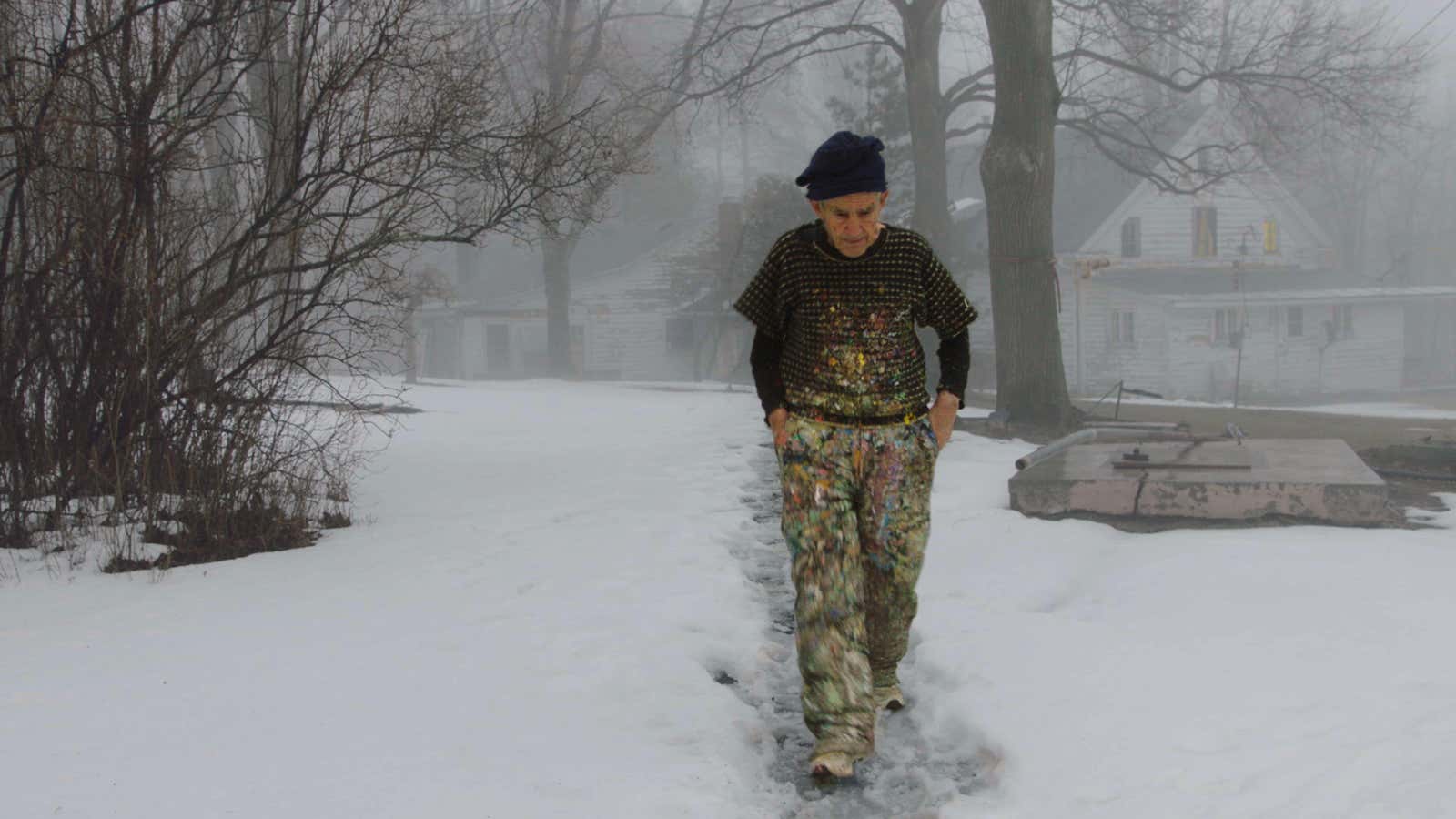A single table-scape by the painter Manny Farber contains more life than many galleries. He painted surfaces littered with everyday detritus: handwritten notes on slips of paper, punnets of berries, root vegetables piled into colanders, vases of wilting homegrown flowers, rulers, matches, day planners, and half-finished glasses of water.
“Do everything at once yoga, writing, fucking, painting, teaching,” reads the cursive script on a slip of lined yellow paper sitting beneath a roll of tape and asparagus spear in one such painting.

Farber, who died in 2008, was a champion of what he called “termite art”: work intensely concentrated on craft, that burrowed through the landscape of daily life. A film critic and painter—and a professor of both mediums at the University of California San Diego—Farber coined the term in a 1962 essay, published in Film Culture, “White Elephant Art vs. Termite Art.”
“What a termite art aims at,” he wrote, is “buglike immersion in a small area without point or aim, and, over all, concentration on nailing down one moment without glamorizing it, but forgetting this accomplishment as soon as it has been passed; the feeling that all is expendable, that it can be chopped up and flung down in a different arrangement without ruin.”
White elephant art, on the other hand, is too often suffocated under its own grandeur, squandering what he called “the special delight” in great artists’ techniques in service of a so-called masterpiece.
A series of “termite arts” by Farber and others are given the masterpiece treatment at a new exhibition at MOCA in Los Angeles: One Day at a Time: Manny Farber and Termite Art, which opened on Oct. 14.
The exhibit suffers no shortage of special delights. Even the curator’s introduction, which feels more personal and heartfelt than the average paragraph on a wall at an exhibit’s entrance is among them. “This is a show dedicated to the everyday, to the things that matter most, even if they don’t last,” writes MOCA’s former chief curator, Helen Molesworth. “This is an exhibition about love and life and the fabric of time that holds them together.”
In addition to Farber’s table-scapes, there are contemporary domestic scenes painted by Jonas Wood, Aliza Nisenbaum, Becky Suss, Patricia Patterson, and more. There are also photographs of Elizabeth Taylor’s belongings by Catherine Opie; a Lorna Simpson video installation of 31 monitors depicting a nameless woman performing the menial tasks and rituals that make up a day, a month, a year; and a painstakingly and an unexpectedly moving star-dotted night sky by Vija Clemins.
As these works demonstrate, it would be a mistake to consider termite art any less ambitious than masterpiece art. It just concentrates on smaller stuff, as Farber wrote, and will chew through boundaries as it does.
This truth is also evident in the new documentary The Price of Everything, which is out in select theaters now and will air on HBO Nov. 12.
In it, filmmaker Nathaniel Kahn goes behind the scenes and interviews blue-chip artists, auction house executives, gallerists, and critics to examine the tension between creativity and commerce. If you love contemporary art—and particularly, painting—it’s worth it just to watch the likes of Marilyn Minter, George Condo, and Jeff Koons’ minions at work.
The white elephant (or silver bunny?) in the room, of course, is Koons, whose gleaming stainless steel statues have commanded upwards of $25 million at auction.

Meanwhile, the documentary’s termite nibbles away in a rickety barn, hand-slapping paint onto a palette behind an improvised curtain of insulation padding. He is Larry Poons, a painter once associated with contemporaries such as Robert Rauschenberg, Jasper Johns, and Frank Stella (who calls Poons “Mr. Natural”). He fell off the popular radar when he evolved beyond the geometrical abstractions that made him famous in the 1960s.
As the New York Times’ A.O. Scott points out in his review of the film, it would have been easy to make Koons the villain and Poons the martyr, toiling away in relative obscurity for an artist of his caliber. But that would have been lazy and not quite accurate. After all, Poons is still striving, painting, prepping for his comeback via a solo show at a Manhattan gallery. Had he stayed in the heat of the spotlight, the artist says at one point, he doubts he would be alive today.
Endurance, after all, is one of the termite’s superpowers. (Exhibit B: MoMA’s ongoing exhibition, “The Long Run,” of contemporary work from later in artists’ careers.) With the Nigerian-born artist Njideka Akunyili Crosby—in her 30s with a new baby, and paintings newly auctioning for over $1 million—Kahn shows a painter aware of how precarious a rapid rise can be. While hefty auction prices don’t necessarily fatten artists’ pockets immediately, they do ratchet up the pressure.
“There’s a temptation to get [paintings] out fast,” Crosby says, in her east LA studio. “But if I speed up the production of the work, it will take away from all that’s behind the scenes that makes the work as rich as it is.”

“It’s not about making a lot of money in the next five years and buying a beautiful house in LA—although that would be good!” she laughs. “But that’s not my driving force.” She wants her work to hang in museums, she says, for future generations. Sure, her work might just sit in storage if she falls out of fashion, but then, it could re-emerge. “Someday, maybe in 50 years, maybe in 70, maybe in 150, it could come out. It doesn’t just vanish.”
The real joy in this movie is watching painters paint—and fight for the focus and inspiration necessary to maintain that privilege.
This post was adapted from the Quartzy newsletter. Subscribe to receive it in your inbox each Friday.
